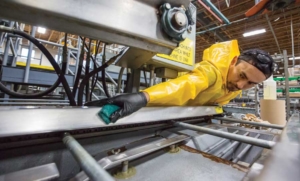Inspections under the Food Safety Modernization Act are coming to orchards and packing plants in 2018 and, with just a year to go, many facilities still aren’t sure how to demonstrate compliance.

Alejandro Garcia hand scrubs a packing line conveyor system. (TJ Mullinax/Good Fruit Grower file photo)
That makes this year key for figuring out what aspects of the regulations apply to your operation as well as attending workshops, training staff, and asking questions that industry groups can relay to federal regulators, according to food safety speakers at the 2016 Washington State Tree Fruit Association annual meeting.
FSMA’s goal is to prevent outbreaks of foodborne illness by requiring preventative controls across the food supply. Two of its rules, the Produce Safety and Preventive Controls for Human Food rules, are expected to have a big impact on the fruit industry.
On-farm, that means documenting irrigation water sampling, equipment sanitation, and worker hygiene. But any facility that packs or stores fruit and doesn’t meet FMSA’s definition of secondary farm is also subject to the Preventive Controls for Human Food rule.
Understanding how your operation is structured — how much fruit from other growers you process and store, for example — is key to figuring out if you qualify as a farm or if you have to comply with the Preventive Controls rule, said Laura Grunenfelder, technical issues manager for the Northwest Horticultural Council.
That rule was designed with major food processing plants in mind, and the Food and Drug Administration has not made it clear exactly how it will be applied to fruit packing, said Kate Woods, vice president of the Northwest Horticultural Council.
But the main requirements of the law are clear: have one certified, trained individual on staff, ensure employees have received food safety training as needed for their respective roles, and write a hazard analysis that spells out areas of risk and the preventive controls in place.
For fresh fruit, since there is no “kill step” in processing, the preventive focus is on sanitation.
In many cases, compliance may not be as daunting as it sounds. It’s mostly a matter of documenting existing good manufacturing practices designed to keep fruit and equipment clean, speakers said.
“With apples, we’re already doing a lot compared to other produce because of our long-term storage. We’re already ahead of the curve,” said Glade Brosi, who manages research and development for Stemilt Growers. “It comes down to, what do the feds want? The feds want paperwork. You are already doing this stuff; you just have to write it down.”
And Allan Brothers’ process engineer Matt Miles added that making your facility easier to clean will make it easier to comply with new regulations. The key, he said, is to be honest with your risk assessment and use tools — such as ATP (adenosine triphosphate) tests for hygiene monitoring — to show where things are clean and what needs to be improved.
Research into easier to clean equipment and other ways to help growers and packers find the best strategies for compliance is well underway. That includes investigating the possibility of meeting water test requirements at the irrigation district level rather than on each farm, the best sanitation practices for packing lines, and how to show that preventive controls are working.
But panels urged people not to just wait for more research and guidance from the FDA and to start taking steps now to be in compliance in 12 months.
“We’re in a critical time,” Woods said. “Start looking at what you are confident enough to make changes on and work toward those and get those questions ready (for us), because the quicker we get those answers, the easier it will be for you to make changes that the inspectors who are going to show up will accept.” •
Video
Jacqui Gordon Nuñez discusses the importance of hand washing as part of the food safety process from orchard through packing house to consumer.
– by Kate Prengaman
As the industry gears up for FSMA this year, Good Fruit Grower is launching a new, occasional column to explore common questions, new research and other impacts from the new regulations. Please let us know what you need to know and stay tuned for a busy year on the food safety front. Please contact Senior Editor Shannon Dininny at shannon@goodfruit.com.






Leave A Comment